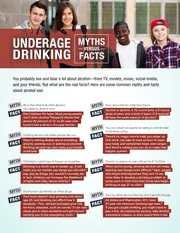
Underage Drinking: Myths versus Facts PDF
Preview Underage Drinking: Myths versus Facts
You probably see and hear a lot about alcohol—from TV, movies, music, social media, and your friends. But what are the real facts? Here are some common myths and facts about alcohol use. M Y T H All of the other kids drink alcohol. M Y T H Beer and wine are safer than liquor. You need to drink to fit in. Alcohol is alcohol. A 12-ounce beer, a 5-ounce F A C T Don’t believe the hype: Most young people F A C T glass of wine, and a shot of liquor (1.5 ounces) don’t drink alcohol! Research shows that all have the same amount of alcohol.6 almost 82 percent of 12- to 20-year-olds haven’t had a drink in the past month.1 M Y T H You can sober up quickly by taking a cold shower or drinking coffee. M Y T H Drinking alcohol will make people like you. F A C T There’s no magic cure to help you sober up. There’s nothing likable about stumbling One drink can take at least an hour to leave F A C T around, passing out, or puking on yourself. your body and sometimes takes even longer.7 Drinking alcohol can also make your breath And there’s nothing you can do to make that smell bad. happen quicker. M Y T H Drinking is a good way to loosen up at parties. M Y T H There’s no reason to wait until you’re 21 to drink. Drinking is a dumb way to loosen up. It can When you’re young, drinking alcohol can make F A C T make you act foolish, say things you shouldn’t F A C T learning new things more difficult.8 Also, people say, and do things you wouldn’t normally do. who begin drinking before they turn 15 are In fact, drinking can increase the likelihood more likely to develop a drinking problem at of fights and risky sexual activity.2 some point in their lives than those who begin drinking at age 21 or older.9 M Y T H Alcohol isn’t as harmful as other drugs. M Y T H You can drink alcohol and you won’t get into trouble. Your brain doesn’t stop growing until about F A C T age 25, and drinking can affect how it All states and Washington, D.C. have develops.3 Plus, alcohol increases your risk F A C T 21-year-old minimum-drinking-age laws.10 for many diseases, such as cancer.4 It can also If you get caught drinking, you might have to cause you to have accidents and get injured, pay a fine, do community service, take alcohol sending you to the emergency room.5 awareness classes, or even spend time in jail. Think you or your friend has an alcohol problem? Don’t wait—get help. Talk to a parent, doctor, teacher, or anyone you trust. If you’re more comfortable speaking with someone you don’t know, call the confidential SAMHSA National Helpline at 800–662–HELP (800–662–4357) (English and Spanish). You can find substance abuse treatment services near you at samhsa.gov/treatment. M O R E Learn more about underage drinking at I N F O stopalcoholabuse.gov. 1 Substance Abuse and Mental Health Services Administration. (2020). Key substance use and mental health indicators in the United States: Results from the 2019 National Survey on Drug Use and Health (HHS Publication No. PEP20-07-01-001, NSDUH Series H-55). Retrieved from https://www.samhsa.gov/data/ report/2019-nsduh-annual-national-report 2 Substance Abuse and Mental Health Services Administration. (2018). Report to Congress on the Prevention and Reduction of Underage Drinking. Retrieved from https://www.stopalcoholabuse.gov/resources/reporttocongress/rtc2018.aspx 3 U.S. Department of Health and Human Services. (2017). Facing Addiction in America: The Surgeon General’s Report on Alcohol, Drugs, and Health. Retrieved from https://www.stopalcoholabuse.gov/resources/reporttocongress/rtc2018.aspx 4 National Cancer Institute. (2020). Cancer Trends Progress Report: Alcohol Consumption. Retrieved from https://www.progressreport.cancer.gov/prevention/ alcohol 5 Naeger, S. (2017). Emergency department visits involving underage alcohol use: 2010 to 2013. The CBHSQ Report. Center for Behavioral Health Statistics and Quality, Substance Abuse and Mental Health Services Administration, Rockville, MD. Retrieved from https://www.samhsa.gov/data/sites/default/files/ report_3061/ShortReport-3061.html 6 C enters for Disease Control and Prevention. (2020). Alcohol and Public Health: Frequently Asked Questions About Alcohol. Retrieved from https://www.cdc.gov/ alcohol/faqs.htm 7 C ederbaum, A. I. (2012). Alcohol metabolism. Clinics in Liver Disease, 16(4), 667–685. Retrieved from https://www.ncbi.nlm.nih.gov/pmc/articles/ PMC3484320/ 8 U.S. Department of Health and Human Services, Substance Abuse and Mental Health Services Administration. (2018). Report to Congress on the Prevention and Reduction of Underage Drinking. Retrieved from https://www.stopalcoholabuse.gov/resources/reporttocongress/rtc2018.aspx 9 G rant, B. F., & Dawson, D. A. (1997). Age at onset of alcohol use and its association with DSM-IV alcohol abuse and dependence: Results from the National Longitudinal Alcohol Epidemiologic Survey. Journal of Substance Abuse, 9, 103–110. 10 U .S. Department of Health and Human Services. (2016). Facing Addiction in America: The Surgeon General’s Report on Alcohol, Drugs, and Health. Retrieved from https://www.ncbi.nlm.nih.gov/books/NBK424850/ PEP21-03-10-007 First printed 2008. Revised 2021.
